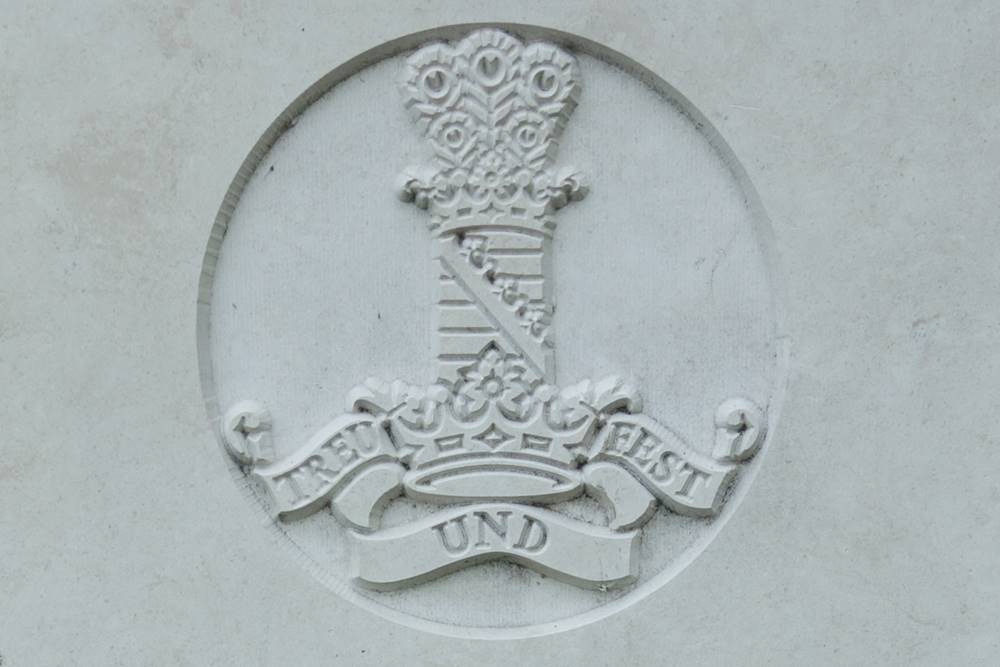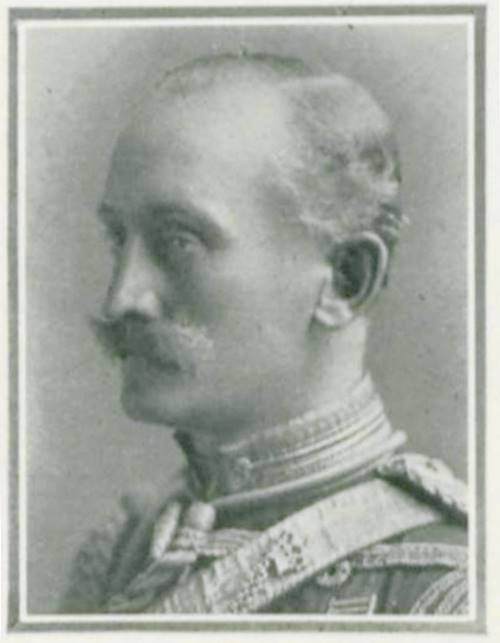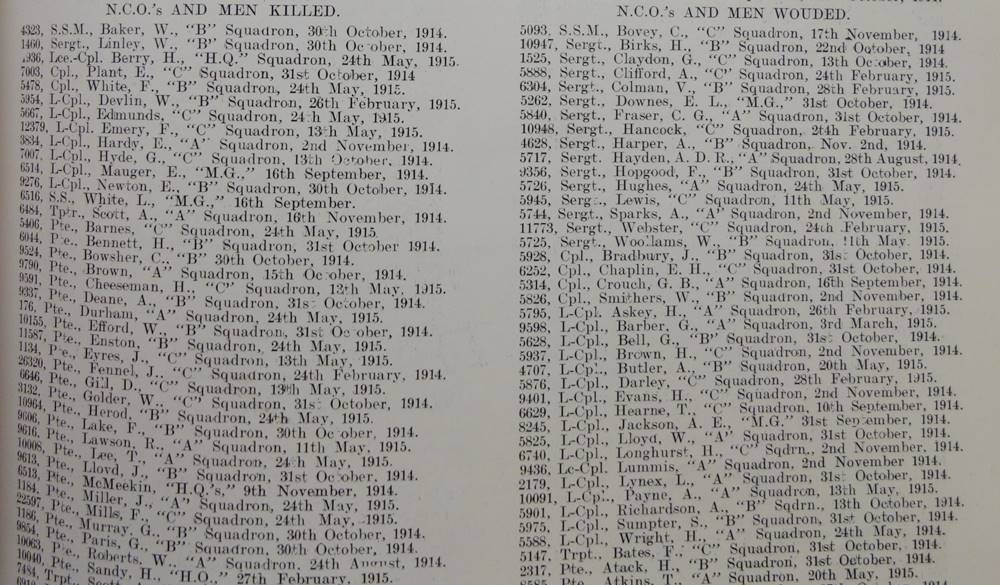This article on the 11th (Prince Albert’s Own) Hussars will provide you with an overview of the Regiment’s activities during the First World War and will help you to research a soldier who served with the Regiment. I have also written a series of guides to help you research British soldiers who served in the war:
The 11th (Prince Albert’s Own) Hussars in the First World War

The 11th Hussars was stationed at Aldershot on 4 August 1914 when Britain declared war on Germany. Receiving orders to mobilize shortly after the declaration, the Regiment landed in France as part of the 1st Cavalry Brigade of the Cavalry Division on 16 August. This Division was redesignated as the 1st Cavalry Division on 16 September 1914 and the 1st Cavalry Brigade served in this formation for the remainder of the war on the Western Front. Between 26 August 1914 and 6 November 1918, the Commonwealth War Graves Commission recorded that 165 soldiers of the Regiment died. The 11th Hussars suffered its heaviest casualties in the war at the First and Second Battles of Ypres and during the opening days of the German Spring Offensive in March 1918. The best source of information for learning more about the Regiment and its role in the First World War is its war diary which I have discussed below and History of the Eleventh Hussars (Prince Albert’s Own), 1908-1934 by Capt. L. R. Lumley.
Researching a Soldier who Served in the 11th Hussars in the First World War
I have created a series of generic research guides to help you research soldiers who served in the Regiment during the war. Those looking at service and medal records are the best starting points. Also, I have a page on military abbreviations and acronyms which will be of help as you’ll encounter a lot of military jargon. I’d recommend downloading the 11th Hussars’ war diary if you want to find out the unit’s locations and activities during the war.
Officers: A service record, if one has survived, is the most important document to find and start by searching for one at the National Archives. If an officer served past April 1922 then it will still be held by the Ministry of Defence: Ordering a Service Record from the MOD. The Regiment’s war diary contains the names of some of the officers but not all. For the date an officer was commissioned and subsequent promotions, look in the London Gazette and Hart’s Army List. Newspapers are a good resource to use when trying to find a photograph of an officer or information regarding a casualty. The regimental history records all the officers who served with the Regiment during the war and provides a brief account of their service.
Captain John Alexander Halliday who died of wounds on 13 November 1914 and is buried in the Chicklade (All Saints) Churchyard, Wiltshire. This photograph was published in the Bond of Sacrifice, an important source to use when researching early officer casualties.
Other Ranks: First have a look for a service record, though many were destroyed in the Blitz. If a soldier served past January 1921 then the National Archives should hold the service record. Ordering a copy is a straightforward process and no death certificate is needed. You can often work out when a soldier joined the 11th Hussars from their regimental number. Though you have to be careful, as there are two numbering series. Prior to 1907, each hussar regiment numbered their men separately, so there will be soldiers serving in the different hussar regiments with the same regimental number. This was changed in late 1906, so the next year all soldiers joining the Corps of Hussars received a number from the same series. The History of the Eleventh Hussars (Prince Albert’s Own), 1908-1934 contains a complete list of casualties sustained by the Regiment during the war along with the date and place they became a casualty.
To research either an officer or other rank who served in the First World War, you’ll need to view the records available on both FindmyPast and Ancestry Both sites offer a free trial period and if you live in Britain you can often access them at your local library.
War Diary of the 11th (Prince Albert’s Own) Hussars
A war diary was kept by an officer of a unit and recorded its location and activities. They are the most important documents to view if you want to research a unit during the war. There is only one war diary for the 11th Hussars which can be downloaded from the National Archives’ website for a small fee by clicking on the blue link below. The war diary of the 1st Cavalry Brigade can also be downloaded which will contain additional information for the Regiment. Its catalogue reference is WO 95/1108/1.
- Date: 15 August 1914 – 15 February 1919
- 1st Cavalry Brigade, 1st Cavalry Division
- Reference: WO 95/1109/3
- Notes: An average war diary where many of the months consist of a short summary rather than daily entries. However, the entries for 1914 are more detailed and there is a report on the attack by the 1st Cavalry Brigade at Nery on 1 September 1914. Included in the war diary for 1914 are pages from the XI Hussar Journal.
Regimental History and Journal
There is an excellent regimental history which was published in 1936 but it is difficult to obtain as it hasn’t been reprinted: History of the Eleventh Hussars (Prince Albert’s Own), 1908-1934 by Capt. L. R. Lumley. I looked at a copy at the British Library. This book contains a readable account of the Regiment’s activities and is packed full of useful information including the locations the unit served during the war as a timeline, a complete list of battle casualties, honours, small biographies of officers, maps etc. There is also a list of soldiers who landed in France with the Regiment in August 1914 divided into squadrons.
The Regiment published the XI Hussars Journal during the war with the British Library holding the October 1914 and October 1915 issues. A lot of the information was drawn from the unit’s war diary but the latter volume includes a list of casualties suffered by the Regiment. An extract from this list is shown below and as you can see, it states what part of the 11th Hussars the soldier was serving in when they became a casualty.
Extract from the War Diary of the 11th Hussars
15 August 1914 – 15 February 1919, 1st Cavalry Brigade, WO 95/1109/3
Report by Lieutenant J. G. Bannatyne, 11th Hussars of Events August 26 1914
Early on the morning of August 26th I was ordered by Lieutenant-Colonel Pitman between Catillon and Le Cateau to take my troop and get into communication with General Gough’s Brigade, to ask him for information and leave connecting files with the regiment. As I was leaving the village I met a staff officer who told me that he had come from General Gough with orders to Colonel Pitman to join him. At the outskirts of the village I was informed by the natives that a Brigade consisting chiefly of lancers had gone on the road to Bohain which I followed, leaving connecting files.
On reaching Bohain I heard that this was the 2nd Cavalry Brigade and I joined there a detachment of 5th Dragoon Guards under Captain Norwood also looking for 1st Cavalry Brigade. I saw a message there from General De Lisle to General Gough telling him that Cavalry Division was concentrating at a town west of Bohain and saying that he was going there via Saint-Quentin. Together with party of 5th Dragoon Guards I went to Saint-Quentin, but found on arrival there that 2nd Cavalry Brigade had not passed. As horses were unable to go further we halted at Flying Corps Camp and on 27th saw a notice from Headquarters saying that all cavalry were to concentrate south of river in neighbourhood of Bretigny.
Reached Bretigny on evening of 27th and late on 28th heard that a detachment of regiment under Captain Sutton was at Pontoise. I joined his party on the morning of August 29th and with them marched at 8.30 pm to join HQ of regiment at Brailly which was reached at 1.45 am on the 30th when we bivouacked and joined the regiment at 9 am on that day.
Dated 24 September 1914.


